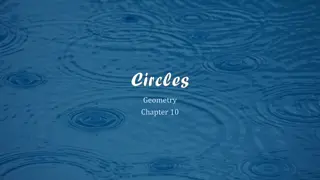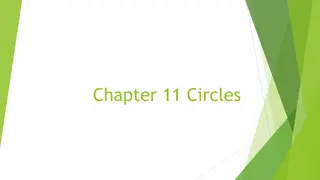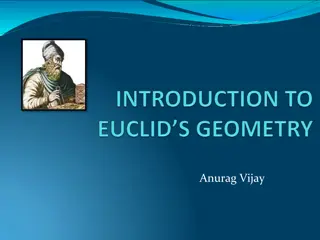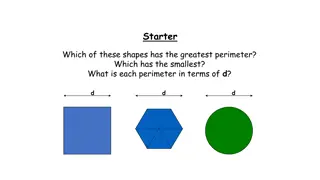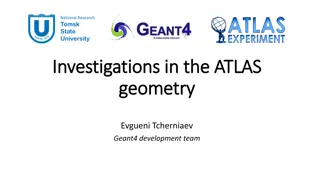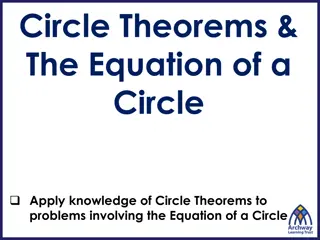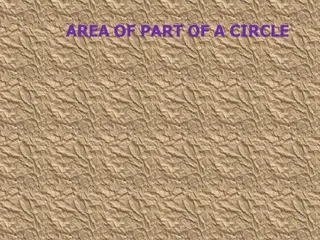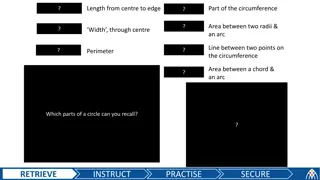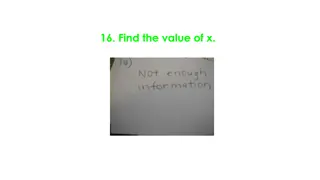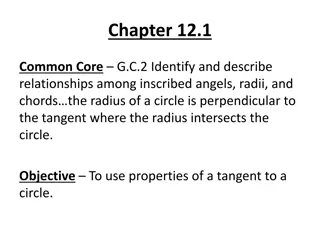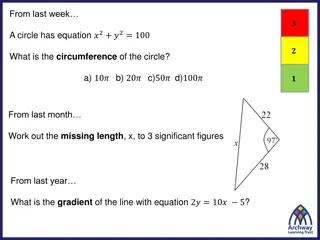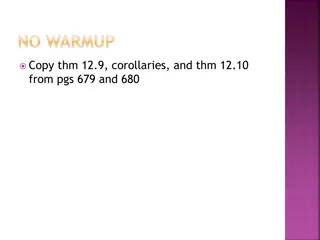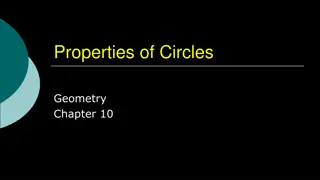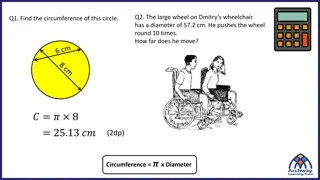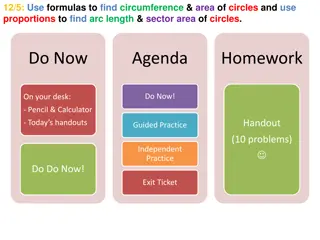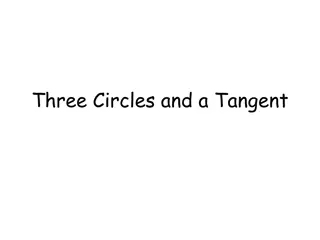Understanding Circles in Geometry with Dr. Geoff F. Clement
Delve into the realm of circles in geometry with Dr. Geoff F. Clement as your guide. Explore the definitions of circles, arcs, central angles, congruent circles, and more. Uncover the properties of circles, such as diameters being twice the radius, congruence postulates, and arc measures. Dive into the world of inscribed angles and the arc addition postulate to enhance your understanding of geometric concepts.
Download Presentation

Please find below an Image/Link to download the presentation.
The content on the website is provided AS IS for your information and personal use only. It may not be sold, licensed, or shared on other websites without obtaining consent from the author. Download presentation by click this link. If you encounter any issues during the download, it is possible that the publisher has removed the file from their server.
E N D
Presentation Transcript
Math 3301 Foundations of Geometry Chapter 6 Circles Dr. Geoff F. Clement
6.1 Circles and Arcs Definition: A circle is the set of all points in a plane that are located a fixed distance from a fixed point called the center. A line segment joining the center of the circle to one of its points is called the radius of the circle.
6.1 Circles and Arcs Theorem 6.1: The diameter d of a circle is twice the radius r of the circle. That is, d = 2r.
6.1 Circles and Arcs Postulate 6.1 (Congruent Circles): If two circles are congruent, then their radii and diameters are congruent. Conversely, if the radii or diameters are congruent, then two circles are congruent.
6.1 Circles and Arcs Definition: An arc of a circle forms a continuous part of the circle. An arc of a circle whose endpoints are the endpoints of a diameter of the circle is called a semicircle. An arc that is longer than a semicircle is called a major arc of the circle, and an arc that is shorter than a semicircle is called a minor arc of the circle.
6.1 Circles and Arcs Definition: An angle with sides that are radii of a circle and vertex the center of the circle is called a central angle.
6.1 Circles and Arcs Definition: The measure of an arc is the number of degrees in the central angle that intercepts the arc. Congruent arcs are arcs with equal measure.
6.1 Circles and Arcs Postulate 6.2 (Arc Addition Postulate):
6.1 Circles and Arcs Definition: An angle whose vertex is on a circle and whose sides intersect the circle in two other points is called an inscribed angle.
6.1 Circles and Arcs Theorem 6.2: The measure of an inscribed angle is one-half the measure of its intercepted arc.
6.1 Circles and Arcs Corollary 6.3: Inscribed angles that intercept the same or congruent arcs are congruent.
6.1 Circles and Arcs Corollary 6.4: Every angle inscribed in a semicircle is a right angle.
6.2 Chords and Secants Definition: A line segment joining two distinct point on a circle is called a chord of the circle.
6.2 Chords and Secants What is the longest chord in a circle?
6.2 Chords and Secants Theorem 6.5: When two chords of a circle intersect, the measure of each angle formed is one-half the sum of the measures of its intercepted arc and the arc intercepted by its vertical angle.
6.2 Chords and Secants Theorem 6.6: In the same circle, the arcs formed by congruent chords are congruent. Theorem 6.7: In the same circle, the chords formed by congruent arcs are congruent.
6.2 Chords and Secants Definition: A line that divides an arc into two arcs with the same measure is called a bisector of the arc.
6.2 Chords and Secants Theorem 6.8: A line drawn from the center of a circle perpendicular to a chord bisects the chord and the arc formed by the chord.
6.2 Chords and Secants Theorem 6.9: A line drawn from the center of a circle to the midpoint of a chord (not a diameter) or to the midpoint of the arc formed by the chord is perpendicular to the chord.
6.2 Chords and Secants Theorem 6.10: In the same circle, congruent chords are equidistant from the center of the circle.
6.2 Chords and Secants Theorem 6.11: In the same circle, chords equidistant from the center of the circle are congruent.
6.2 Chords and Secants Theorem 6.12: The perpendicular bisector of a chord passes through the center of the circle.
6.2 Chords and Secants How to find the center of a circle
6.2 Chords and Secants Theorem 6.13: If two chords intersect inside a circle, the product of the lengths of the segments on one chord is equal to the product of the lengths of the other chord.
6.2 Chords and Secants Definition: If a line intersects a circle in two points, the line is called a secant.
6.2 Chords and Secants Theorem 6.14: If two secants intersect forming an angle outside the circle, then the measure of this angle is one-half the difference of the measures of the intercepted arcs.
6.2 Chords and Secants Theorem 6.15: If two secants are drawn to a circle from an exterior point, the product of the lengths of one secant segment and its external segment is equal to the product of the lengths of the other secant segment and its external segment.
6.3 Tangents Definition: If a line intersects a circle in one and only one point, the line is called a tangent to the circle. The point of intersection is called a point of tangency.
6.3 Tangents Postulate 6.3: If a line is perpendicular to a radius of a circle and passes through the point where the radius intersects the circle, then the line is a tangent.
6.3 Tangents Postulate 6.4: A radius drawn to the point of tangency of a tangent is perpendicular to the tangent.
6.3 Tangents Construction 6.1: Construct a tangent to a circle at a given point on the circle.
6.3 Tangents Construction 6.2: Construct a tangent to a circle from a point outside the circle.
6.3 Tangents Theorem 6.16: The angle formed by a tangent and a chord has a measure one-half the measure of its intercepted arc.
6.3 Tangents Theorem 6.17: The angle formed by the intersection of a tangent and a secant has a measure one-half the difference of the measures of the intercepted arcs.
6.3 Tangents Theorem 6.18: The angle formed by the intersection of two tangents has a measure one-half the difference of the measures of the intercepted arcs.
6.3 Tangents Theorem 6.19: Two tangent segments to a circle from the same point have equal lengths.
6.3 Tangents Theorem 6.20: If a secant and a tangent are drawn to a circle from an external point, the length of the tangent segment is the geometric mean between the length of the secant segment and the external segment. a2 = b(b + c)
6.3 Tangents Definition: The line passing through the centers of two circles is called their line of centers.
6.3 Tangents Theorem 6.21: If two circles are tangent internally or externally, the point of tangency is on their line of centers.
6.3 Tangents Theorem 6.22: If two circles intersect in two points, then their line of centers is the perpendicular bisector of their common chord.
6.3 Tangents Construction 6.3: Construct a common external tangent to two given circles that are not congruent.
6.3 Tangents Construction 6.4: Construct a common internal tangent to two given circles.
6.4 Circles and Regular Polygons Definition: If a polygon has its vertices on circle, the polygon is inscribed in the circle, and the circle is circumscribed around the polygon. If each side of a polygon is tangent to a circle, the polygon is circumscribed around the circle, and the circle is inscribed in the polygon.
6.4 Circles and Regular Polygons Theorem 6.23: If a quadrilateral is inscribed in a circle, the opposite angles are supplementary.
6.4 Circles and Regular Polygons Theorem 6.24: If a parallelogram is inscribed in a circle, then it is a rectangle.
6.4 Circles and Regular Polygons Theorem 6.25: If a circle is divided into n equal arcs, n >2, then the chords formed by these arcs form a regular n-gon.
6.4 Circles and Regular Polygons Theorem 6.26: If a circle is divided into n equal arcs, n > 2, and tangents are constructed to the circle at the endpoints of each arc, then the figure formed by these tangents is a regular n-gon.
6.4 Circles and Regular Polygons Construction 6.5: Construct a circle that is circumscribed around a given regular polygon.




